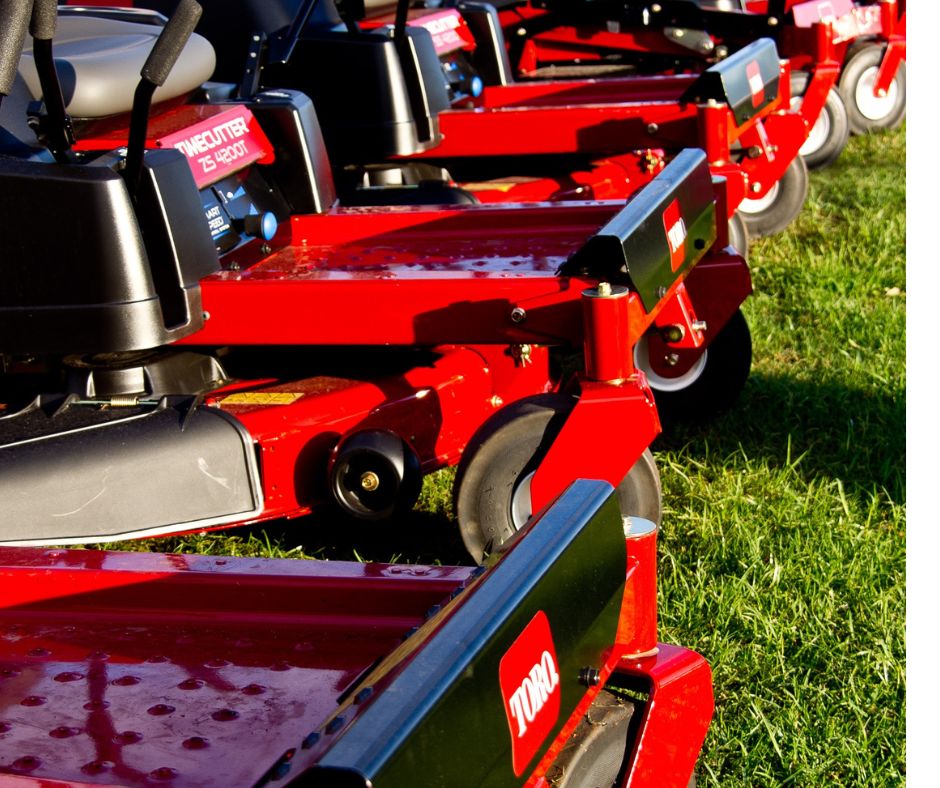
The end of the mowing season is in sight for those living in more northern climates! Chance are, your mowers got a good workout. Maybe even some of those seasonal workers dinged them up, so they have a few new battle scars.
After the last mowing, don’t just roll the mowers to the back of the garage and forget about them until spring. The end of the mowing season is a perfect time for inspecting and winterizing commercial lawn mowers.
After all, you want to ensure the mowers store well in the winter. They need to be ready for that spring grass that sometimes seems to bolt out of the ground overnight.
Here are some things to do before the mowers make it into storage for a well-deserved break.
Inspect for Damage
Start by inspecting and recording any damage you notice on the mower’s body. Pay special attention to the deck and undercarriage, which can take a lot of abuse. If you have records from previous years, pinpoint if the damage was caused this year.
Other areas to inspect:
- Blades: Check mower blades for sharpness and damage.
- Hardware: Vibrating machinery and bumpy terrain can slowly loosen hardware on the mower. Ensure bolts, screws, and any other fastening material are there and tight.
- Tires: Tires will probably need filling while preparing mowers in the spring, but look for signs of wear and tear on the tires that may indicate an alignment problem.
- Belts: Tighten or replace any loose or worn belts.
- Moving Parts: Check and lubricate any moving parts per your owners’ manual instructions.
Clean the Mowers
Wash off all the grass clippings, dirt, and other debris that’s accumulated in and on the mowers this growing season. Wipe down the outside and inside of the mowers. Even tiny bits of dirt and grass can eventually take their toll on the engine’s performance.
Don’t forget the deck and undercarriage. Some car wash detergent, a hose, putty knife, and a little elbow grease will help remove the caked-on organic material layer stuck in the undercarriage.
Empty or Stabilize the Gasoline
With all the extra money spent on gasoline this year, the idea of running the mowers just to burn gas may seem a little wasteful.
Gasoline or diesel fuel left for more than two weeks in mowers oxidizes and deteriorates. The result is a thick substance that will require service when it clogs the fuel lines or the carburetor jet opening.
If you don’t want to run the mowers until they run out of gas, add a fuel stabilizer to the gas tank. Then run the mowers for 5 to 10 minutes so the stabilizer can fully incorporate.
Finally, clean the fuel cap. Clean any dirt or bits of grass with a paintbrush. Be sure the cap fits tightly and correctly after you close it.
Change Oil and Filter
Oil doesn’t break down as quickly as gasoline, so you could technically store the mower with oil in it. But, since your crew is already doing preventative maintenance on the mowers, a little extra time changing the oil and filter now saves time in the spring.
Remove the Battery
Wipe the battery down to remove organic matter. Clean the terminal with a terminal cleaner or metal brush. Store in a cool, dry location away from any sources of heat
Another option to consider is using a battery tender, also called a battery maintainer. Batteries can discharge and lose their charge when sitting for a long time. A battery tender charges the battery and then stops once fully charged. Then, the tender starts charging again when the battery drops below a certain voltage.
Remove the Spark Plug
An efficient mower relies on a functioning spark plug. Take out the spark plug and look for any signs of wear and tear. If they haven’t been replaced all season, now may be a good time to put a new spark plug in your mower.

Keep Records of Maintenance Performed
Be sure each technician documents the inspection findings and maintenance work performed on each mower. Records ensure work doesn’t get missed or done too frequently.
For example, the new maintenance supervisor ordered oil changes for all the mowers in the spring because there was no documentation the oil changes were completed during the winterizing process. The result: wasted time, manpower, and oil.
Digital records are an easier way to document inspections and work completed. For example, records kept in a computerized maintenance management system (CMMS) can be accessed from any web-enabled device.
A CMMS allows you to set up preventive maintenance tasks--like winterizing your mowers--well in advance and assign them to the appropriate staff. That staff could report the findings and even fill out an inspection report. That report can be accessed by anyone with the appropriate credentials from any web-enabled device.
Tasks don’t get missed. Your equipment stays in better shape. And preparing the mowers when spring rolls around will be that much easier.
